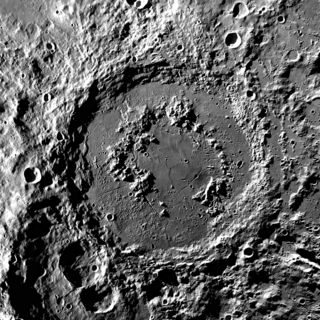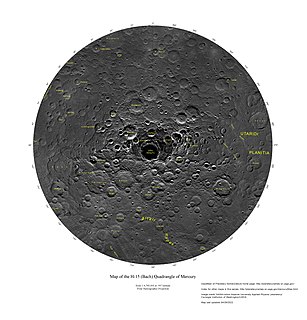Examples
- Barton crater, a peak-ring crater on Venus
- West Clearwater Lake (upper left) on Earth
- Schrödinger, a peak-ring crater on the Moon
A peak ring crater is a type of complex crater, which is different from a multi-ringed basin or central-peak crater. A central peak is not seen; instead, a roughly circular ring or plateau, possibly discontinuous, surrounds the crater's center, with the crater rim still farther out from the center.
The rings form by different processes, and inner rings may not be formed by the same processes as outer rings. [1]
It has long been the view that peak rings are formed in the stage subsequent to central peak formation in craters. The central peaks of craters are believed to originate from hydrodynamic flow of material lifted by inward-collapsing crater walls, while impact-shattered rock debris is briefly turned to fluid by strong vibrations that develop during crater formation. The peak-ring structure of Chicxulub crater was probably formed as inward-collapsing material struck the over-steepened central peak, to form a hydraulic jump at the location where the peak ring was located. [2]
Other theories have been formulated. Perhaps, in the case of Chicxulub crater, an over-high central peak collapsed into the peak ring. [3] [4]
According to Sean Gulick, a geophysicist at the University of Texas, Chicxulub is Earth's only crater to have an intact peak ring structure. [5] However, a counterexample is shown below at West Clearwater Lake in Canada.
On Mercury:
On Earth:
On the Moon:

An impact crater is a depression in the surface of a planet, moon, or other solid body in the Solar System or elsewhere, formed by the hypervelocity impact of a smaller body. In contrast to volcanic craters, which result from explosion or internal collapse, impact craters typically have raised rims and floors that are lower in elevation than the surrounding terrain. Impact craters range from small, simple, bowl-shaped depressions to large, complex, multi-ringed impact basins. Meteor Crater is a well-known example of a small impact crater on Earth.

The Chicxulub crater is an impact crater buried underneath the Yucatán Peninsula in Mexico. Its center is offshore near the communities of Chicxulub Puerto and Chicxulub Pueblo, after which the crater is named. It was formed when a large asteroid, about 10 kilometers in diameter, struck the Earth. The date of the impact coincides precisely with the Cretaceous–Paleogene boundary, slightly more than 66 million years ago, and a widely accepted theory is that worldwide climate disruption from the event was the cause of the Cretaceous–Paleogene extinction event, a mass extinction in which 75% of plant and animal species on Earth became extinct, including all non-avian dinosaurs.

The lunar geological timescale divides the history of Earth's Moon into five generally recognized periods: the Copernican, Eratosthenian, Imbrian, Nectarian, and Pre-Nectarian. The boundaries of this time scale are related to large impact events that have modified the lunar surface, changes in crater formation through time, and the size-frequency distribution of craters superposed on geological units. The absolute ages for these periods have been constrained by radiometric dating of samples obtained from the lunar surface. However, there is still much debate concerning the ages of certain key events, because correlating lunar regolith samples with geological units on the Moon is difficult, and most lunar radiometric ages have been highly affected by an intense history of bombardment.

The Vredefort crater is the largest verified impact crater on Earth. It was 160–300 km (100–200 mi) across when it was formed; and what remains of it is in the present-day Free State province of South Africa. It is named after the town of Vredefort, which is near its centre. Although the crater itself has long since been eroded away, the remaining geological structures at its centre are known as the Vredefort Dome or Vredefort impact structure. The crater is calculated to be 2.023 billion years old, with impact being in the Paleoproterozoic Era. It is the second-oldest known crater on Earth, after Yarrabubba crater.

Schrödinger is a large lunar impact crater of the form traditionally called a walled plain and is named after Erwin Schrödinger. It is located near the south lunar pole on the far side of the Moon, and can only be viewed from orbit.

Silverpit crater is a buried sub-sea structure under the North Sea off the coast of the island of Great Britain. The 20 km (12 mi) crater-like form, named after the Silver Pit—a nearby sea-floor valley recognized by generations of fishermen—was discovered during the routine analysis of seismic data collected during exploration for gas in the Southern North Sea Sedimentary Basin.

Montes Rook is a ring-shaped mountain range that lies along the western limb of the Moon, crossing over to the far side. It completely encircles the Mare Orientale, and forms part of a massive impact basin feature. This range in turn is encircled by the larger Montes Cordillera, which is separated from the Montes Rook by a rugged, ring-shaped plain.

The Alvarez hypothesis posits that the mass extinction of the non-avian dinosaurs and many other living things during the Cretaceous–Paleogene extinction event was caused by the impact of a large asteroid on the Earth. Prior to 2013, it was commonly cited as having happened about 65 million years ago, but Renne and colleagues (2013) gave an updated value of 66 million years. Evidence indicates that the asteroid fell in the Yucatán Peninsula, at Chicxulub, Mexico. The hypothesis is named after the father-and-son team of scientists Luis and Walter Alvarez, who first suggested it in 1980. Shortly afterwards, and independently, the same was suggested by Dutch paleontologist Jan Smit.

H. Jay Melosh was an American geophysicist specialising in impact cratering. He earned a degree in physics from Princeton University and a doctoral degree in physics and geology from Caltech in 1972. His PhD thesis concerned quarks. Melosh's research interests include impact craters, planetary tectonics, and the physics of earthquakes and landslides. His recent research includes studies of the giant impact origin of the moon, the Chicxulub impact that is thought to have extinguished most dinosaurs, and studies of ejection of rocks from their parent bodies. He was active in astrobiological studies that relate chiefly to the exchange of microorganisms between the terrestrial planets.

Golubkina is a crater on Venus.

The geology of solar terrestrial planets mainly deals with the geological aspects of the four terrestrial planets of the Solar System – Mercury, Venus, Earth, and Mars – and one terrestrial dwarf planet: Ceres. Earth is the only terrestrial planet known to have an active hydrosphere.

The Borealis quadrangle is a quadrangle on Mercury surrounding the north pole down to 65° latitude.

The Tolstoj quadrangle in the equatorial region of Mercury runs from 144 to 216° longitude and -25 to 25° latitude. It was provisionally called "Tir", but renamed after Leo Tolstoy by the International Astronomical Union in 1976. Also called Phaethontias.

The Bach quadrangle encompasses the south polar part of Mercury poleward of latitude 65° S. It is named after the prominent crater Bach within the quadrangle, which is in turn named after Baroque composer Johann Sebastian Bach. The quadrangle is now called H-15.

The Beethoven quadrangle is located in the equatorial region of Mercury, in the center of the area imaged by Mariner 10. Most pictures of the quadrangle were obtained at high sun angles as the Mariner 10 spacecraft receded from the planet. Geologic map units are described and classified on the basis of morphology, texture, and albedo, and they are assigned relative ages based on stratigraphic relations and on visual comparisons of the density of superposed craters. Crater ages are established by relative freshness of appearance, as indicated by topographic sharpness of their rim crests and degree of preservation of interior and exterior features such as crater floors, walls, and ejecta aprons. Generally, topography appears highly subdued because of the sun angle, and boundaries between map units are not clearly defined.

Raditladi is a large peak-ring impact crater on Mercury with a diameter of 263 km. Inside its peak ring there is a system of concentric extensional troughs (graben), which are rare surface features on Mercury. The floor of Raditladi is partially covered by relatively light smooth plains, which are thought to be a product of the effusive volcanism. The troughs may also have resulted from volcanic processes under the floor of Raditladi. The basin is relatively young—probably younger than one billion years, with only a few small impact craters on its floor and with well-preserved basin walls and peak-ring structure.

Complex craters are a type of large impact crater morphology.

Rachmaninoff is a peak-ring impact crater on Mercury. This basin, first imaged in its entirety during MESSENGER's third Mercury flyby, was quickly identified as a feature of high scientific interest, because of its fresh appearance, its distinctively colored interior plains, and the extensional troughs on its floor. The morphology of Rachmaninoff is similar to that of Raditladi, which is one of the youngest impact basins on Mercury. The age of Raditladi is estimated at one billion years. Rachmaninoff appears to be only slightly older.

Renoir is a crater on the planet Mercury. Its name, after the French painter Pierre-Auguste Renoir (1841–1919), was adopted by the International Astronomical Union in 1976.

A multi-ringed basin is not a simple bowl-shaped crater, or a peak ring crater, but one containing multiple concentric topographic rings; a multi-ringed basin could be described as a massive impact crater, surrounded by circular chains of mountains resembling rings on a bull's-eye. A multi-ringed basin may have an area of many thousands of square kilometres.